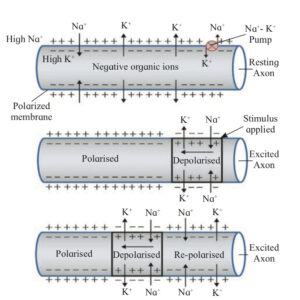 Polarisation and Depolarisation along a nerve
Polarisation and Depolarisation along a nerve
i. A nerve impulse signifies a wave of bioelectrical or electrochemical disruptions coursing through a neuron.
ii. Neurons possess a polarized cellular membrane with distinct voltages on its outer and inner sides. The plasma membrane separates these solutions of differing chemical compounds, despite having approximately the same total number of ions.
iii. The external tissue fluid contains Na+ and K+, with Na+ and Cl- predominantly present, while K+ is prevalent within the fiber or intracellular fluid. This resting nerve condition is known as a polarized state.
iv. The neuron’s polarized state is established by maintaining an excess of Na+ on the outer side, coupled with an excess of K+ internally, along with large negatively charged protein molecules and nucleic acids.
v. Na+ and K+ continuously leak across the membrane, actively maintained by the Na+/K+ pump to uphold the ionic gradient across the resting membrane. The Na-K pump facilitates K+ entry inside the membrane and Na+ exit.
vi. The difference in Na+ and K+ distribution across the membrane produces a potential difference of -50 to -100 millivolts (average is -70 millivolts).
vii. The resting nerve exhibits a potential difference called resting potential (-70 millivolts), primarily due to the resting membrane’s greater permeability to K+ than Na+, causing a slight difference in polarity.
viii. Negatively charged ions, such as proteins and nucleic acids inside the cell, contribute to the overall negative charge inside and positive charge outside. The nerve membrane includes leakage channels and voltage-gated channels for Na+/K+. These channels allow the neuron to alter its membrane potential in response to stimuli, with both gates closed during resting potential.
ix. The resting potential persists unless a stimulus reaches the neuron. Any membrane change or disturbance causes Na+ to enter the membrane, reducing the potential difference below -70 millivolts, rendering the membrane more permeable to Na+.
x. In resting potential, both gates are closed, and Na+ /K+ transport is inactive. During depolarization, Na+ gates open, and K+ gates stay shut, enabling Na+ influx and inducing depolarization.
xi. The extracellular fluid becomes electronegative compared to the inner membrane, leading to an electropositive inner membrane. Action potential values reach +30 to +60 millivolts, triggering depolarization in the next segment as it proceeds to repolarization.